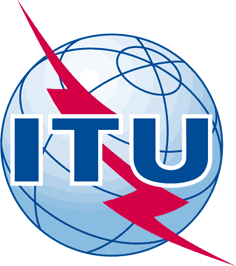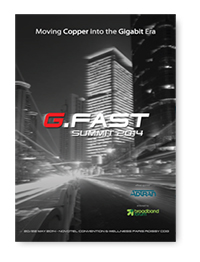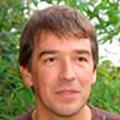| |
|
|
|
| |
|
THURSDAY 22 MAY 2014 | CONFERENCE DAY TWO |
|
| |
|
|
|
| |
|
|
|
| |
official sponsors
 |
| |
 |
| |
| |
endorsed by
 |
| |
 |
| |
| |
| |
| |
| |
| |
| |
download the brochure pdf
 |
| |
|
|
07.45 |
WELCOME, REGISTRATION AND COFFEE |
|
| |
 |
 |
CHAIRMAN
Bernard Dugerdil, Consultant,
|
|
| |
|
|
| |
|
|
| |
The Copper Environment for G.fast |
| |
|
| |
|
|
| |
09.00 |
Spectrum, Crosstalk and the Role of Vectoring in G.fast Networks |
|
| |
|
 |
G.fast spectrum and the impact of crosstalk Understanding the key challenges of vectored G.fast systems and how those challenges can be overcome Energy and performance trade-off considerations.
Jochen Maes
Broadband Innovation Manager
Alcatel-Lucent |
|
|
| |
|
|
|
| |
09.30 |
Crosstalk Impact Introduced by FTTdp Equipment |
|
| |
|
 |
Exploring Orange’s networks topologies in case of FTTdp deployment. Detailing the results of measurements made in the lab in the context of FTTdp using VDSL2 to understand its impact on legacy technologies. Based on these results, a focus will be made on G.fast capacity.
Hubert Mariotte, xDSL Technology Expert, Orange |
|
|
| |
|
|
|
| |
10.00 |
Tone Suppression for Mitigation of Strong Crosstalk |
|
| |
|
Mitigation of strong crosstalk with linear pre-coding results in significant penalty in signal-to-noise-ratio. Discontinuous operations leads to an additional challenge for accurate and timely updates of pre-coding matrices without causing stability problems. Tone suppression can effectively reduce the SNR penalty and hence improve rate-reach performance. Tone suppression can also enable fast and accurate updates of pre-coders while maintaining the stability of the vectored system.
Dong Wei, Huawei |
|
| |
|
|
|
| |
10.30 |
Self-Installation Technological Issues |
|
| |
|
 |
Self-Install is a key point in the deployment of FTTdp architectures Architectural & economical considerations Challenges of a "self-install" model Smooth migration to and from FTTdp Installation at the distribution point & in the home network Regulatory issues/Technological challenges/Home network devices interaction Reverse powering and home network / Status in the ETSI
Stefano Wosz, Product Marketing, Aethra Telecommunications |
|
|
| |
|
|
|
| |
11.00 |
COFFEE BREAK |
|
| |
|
|
|
| |
Panel/Debate |
|
| |
|
|
| |
11.30 |
Is Vectoring useful above 100 MHz? |
| |
|
|
| |
|
 |
MODERATOR
Dave Burstein, Editor, Fast Net News |
|
| |
|
PARTICIPANTS
Hubert Mariotte, xDSL Technology Expert, ORANGE
Dong Wei, Huawei
Jochen Maes, Broadband Innovation Manager, ALCATEL-LUCENT
Stefano Wosz, Product Marketing, AETHRA TELECOMMUNICATIONS |
| |
|
|
| |
|
|
|
| |
|
|
|
| |
12.30 |
LUNCH |
|
| |
|
|
|
| |
Power Supply Strategies |
|
| |
|
| |
|
|
|
| |
14.00 |
Powering and Management of DPU Nodes |
|
| |
|
Providing insight in the opportunities and challenges for reverse powering of small remote nodes in FTTdp deployment,. Proposing solutions and describing the status of standardization. Discussing options for the management of small remote nodes in FTTdp deployment, and describing the status of standardization.
Francois Fredricx, Senior Engineer, Alcatel-Lucent |
|
| |
|
|
|
| |
14.30 |
Reverse Powering – Its Benefits and Constraints |
|
| |
|
Describing a concept that uses power from customer premices to feed network equipments.
Daniel Feldman, Microsemi |
|
|
| |
|
|
|
| |
15.00 |
Report from ATTM-TM6 ETSI WG |
|
| |
|
 |
Describing how ETSI is working on reverse powering of remote network nodes from multiple CPEs by defining architectures showing how to combine reverse power feeding with POTS and data transmission. Management requirements for reverse power feed are also part of this Technical specification.
Trevor Linney, ETSI |
|
|
| |
|
|
|
| |
15.30 |
COFFEE BREAK |
|
| |
|
|
|
| |
Panel/Debate |
|
| |
|
|
| |
16.00 |
Single Power versus Multi-power ? |
| |
|
 |
CHAIRMAN
Bernard Dugerdil, Consultant |
|
| |
|
|
| |
|
|
|
| |
| |
|
|
|
| |
17.00 |
END OF THE CONFERENCE |
|
| |
|
|
|
|
| |
|
|
|
|